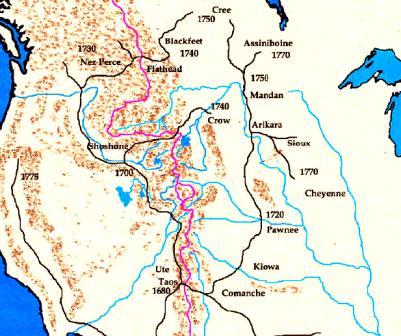Mustang Horse Breed - Description
The colors and markings of the Mustang Horse are numerous due to the mixture of so many different breeds but include spotted, roan, solid black, chestnut, bay, palomino, buckskin, dun, silver dapple, pinto. Their height range from 13 to 16 hands. The weight range of a mustang horse varies according to the species, habitat and life style but is normally 700 to 800 lb (320 - 365 kg). The life expectancy of a wild mustang horse is between 15 to 20 years of age.
History of the Mustang Horse Breeds
It is generally agreed that the horse was first introduced to North America by the Spanish in the 1500's during the conquest of Mexico by the Spanish conquistador, Hernan Cortez (1485 – 1547). The horses brought from Spain were a mixture of Andalusian, Barb and Arabian horse breeds and the Spanish jennet was first introduced by Christopher Columbus. France, under King Louis XIV, began sending horses to Quebec as early as 1665 which were of the Breton and Norman breeds. The English also sent many different breeds with the colonists.
- The Spanish Jennet was a small pacing horse
- The Andalusian breed, also known as the Pure Spanish Horse, is strongly built and known for its prowess as a war horse. Andalusia was a region in southern Spain
- The Barb Horse breed was Developed on the Barbary Coast of North Africa. The Barb is a desert horse with great hardiness and stamina
- The Arabian horse breed was developed in a desert climate by nomadic Bedouin people. Its versatility, speed, endurance and alertness made it highly suitable as a war horse
- France under King Louis XIV began sending horses to Quebec as early as 1665 which were of the Breton and Norman breeds and also coach horses called Percheron Postiers
- Dutch horses included the black Friesian breed
The qualities of these horse breeds, who were the descendants of the American Mustang Horse breed were perfect for riding in the plains and Great Plains and for hunting buffalo. The Mustang Horse was often decorated in Horse War Paint in preparation for battle, as can be seen in the above pictures. The name 'mustang' is derived from the Spanish word 'mesteno' meaning wild or stray.
History of the Mustang Horse - Migration to the North
At first it was difficult for a Native American Indian to acquire a horse but the horses abandoned by the Spanish had gone wild and by the 1700's most of the major Indian tribes had acquired a Mustang horse and had began to move or migrate to the prairies and Great Plains.

Migration of the horse
Native American Culture - Mustang Horse
- Mustang Horse - Native Americans for kids
- Culture and History of Native Indians
- Interesting facts and info about the Mustang Horse for kids and schools
- Information about Mustang Horse and Native American Indians
- Native American Culture - Mustang Horse for kids
Mustang Horse - Pictures and Videos of Native Americans
Mustang Horse. Discover the vast selection of pictures which relate to the History and Culture of Native Americans. The pictures show the clothing, war paint, weapons and decorations of various Native Indian tribes that can be used as a really useful educational history resource for kids and children of all ages. We have included pictures and videos to accompany the main topic of this section - Mustang Horse. The videos enable fast access to the images, paintings and pictures together with information and many historical facts. All of the articles and pages can be accessed via the Native Indian Tribes Index - a great educational resource for kids.